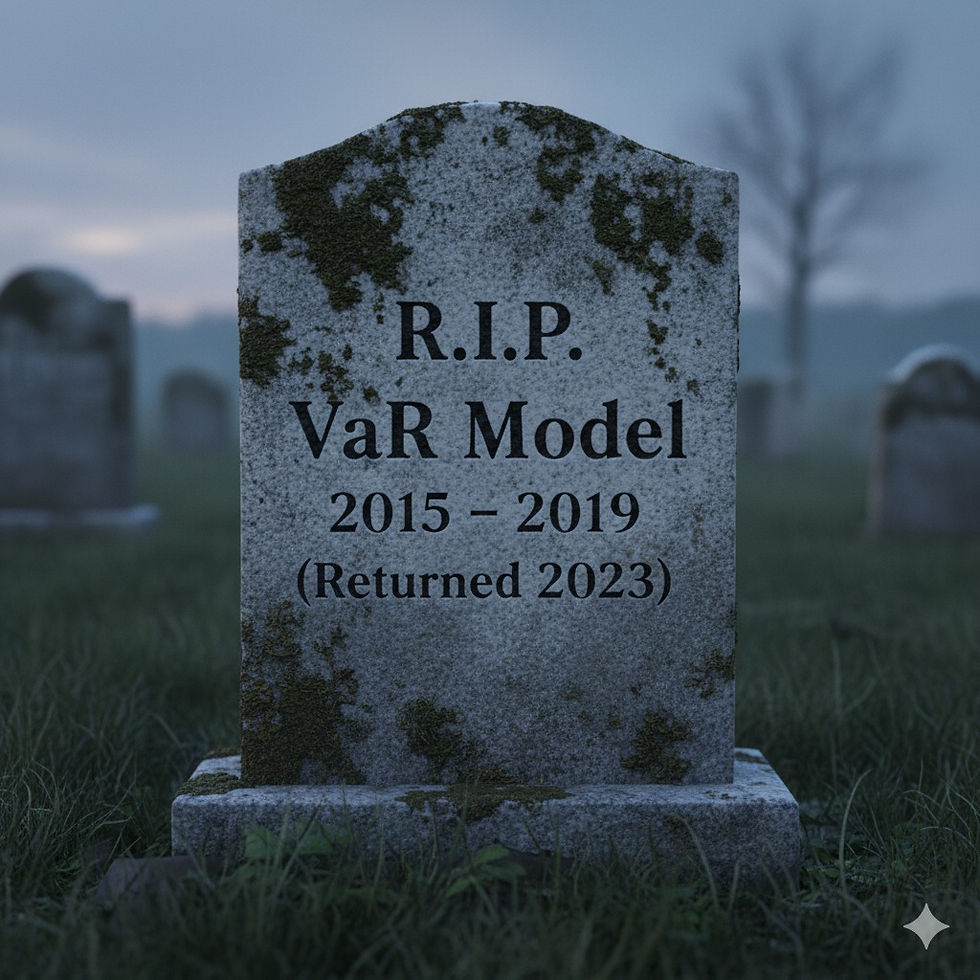🎃 Haunted Model Risk Issues: When Models Come Back to Haunt You
- Ghost Writer

- Oct 29
- 4 min read
Updated: Oct 30
It’s Halloween night in the world of AI and Risk. The lights are dim in the data center, but something is stirring deep within the systems — models that should have been retired long ago whisper back to life. Their logs flicker with activity, unexplained trades appear in audit trails, and risk dashboards pulse with ghostly data points.

No, this isn’t a scene from a sci-fi thriller. It’s what happens when model risk management lapses, when biases are left unchecked, and when old code refuses to die quietly.
Welcome to the haunted corridors of Model Risk — where algorithms rise from the grave, datasets carry ancient curses, and oversight lapses turn into full-blown apparitions.
💀 Rise of the Zombie Models
Every risk manager has seen one — the “zombie model.”
It’s the one that refuses to die because someone insists “it still works.” Maybe it was a top performer during the 2015–2019 era, built for a different market regime. Over time, volatility structures changed, data distributions shifted, and macro correlations evolved — but the model remained in service, patched and reparameterized beyond recognition.

At one global asset manager, an old Value-at-Risk (VaR) model- lovingly maintained but rarely validated — began producing erratic outputs during a period of market stress. Traders used its metrics to rebalance positions, unaware that the model’s assumptions were calibrated to a volatility environment that no longer existed.
By the time validation teams intervened, the model’s outputs bore no relationship to actual risk exposure. It wasn’t alive in a functional sense, but it wasn’t dead either — a perfect zombie.
So, what did we learn?
Model decay is inevitable. Without periodic recalibration, benchmarking, and backtesting, models drift silently until they’re dangerous.
Zombie models survive because they’re comfortable, familiar, and embedded in legacy workflows — but they carry the same threat as any undead creature: they look alive, but they can’t be trusted.
👻 The Algorithm That Wouldn’t Sleep
It began with an anomaly — a small spike in trading volume during off-hours. The firm’s quant team dismissed it as a glitch, until they realized the trades were perfectly structured, executed by an algorithm that was supposed to have been decommissioned two years earlier.

Somewhere in the depths of the system, a forgotten trading model had been reactivated. A routine cloud migration had reconnected it to a live market feed, and without human approval, it began making trades based on outdated signals and broken correlations.
For days, it operated undetected, moving small amounts of capital based on patterns that no longer existed — until the losses began to add up.
The model’s reappearance wasn’t malicious. It was simply forgotten — a ghost in the infrastructure, a process left untagged and unmonitored.
Moral of the story :
AI systems, like restless spirits, need proper closure. When decommissioning a model, ensure its entire lifecycle is sealed — from data access revocation to pipeline disconnection and registry updates.
🕯️ Revenge of the Biased Model
Bias is like a curse — easy to invoke, nearly impossible to banish.
A large financial institution rolled out an AI-based trading recommendation engine designed to support portfolio managers. It had been carefully trained, audited for bias, and validated across multiple asset classes. Yet a few months later, analysts noticed an unsettling pattern: the system was consistently overweighting certain sectors and excluding others without clear rationale.
A forensic review revealed the haunting truth — a “legacy” dataset from pre-validation testing had been accidentally reintroduced during a data refresh. That old dataset contained structural biases reflecting the firm’s historical positions, effectively skewing model behavior toward past preferences.
In other words, the ghost of bias had come back to life.
Lesson from the grave:
Bias doesn’t disappear because you once exorcised it. It lurks in data lineage, caches, and shadow copies. Maintaining fairness and reliability means adopting continuous bias monitoring, explainability tools, and proper data version control.
Without them, your models don’t just make mistakes — they repeat your institutional blind spots, over and over again.

🧛♀️ Lessons from the Haunted Lab
What makes these stories frightening isn’t the technology itself — it’s the absence of discipline and visibility. In every case, the haunting begins when governance loses its grip.
Effective model risk management isn’t about building walls; it’s about maintaining continuous awareness.
Inventory everything. Every model, dataset, and dependency should be traceable from origin to output.
Validate regularly. Don’t just test for accuracy — test for relevance and interpretability.
Retire completely. Decommissioning means disabling data access, removing pipelines, and updating model registries.
Monitor bias and drift. Biases evolve as markets and data sources change; your controls must evolve with them.
In the world of AI and risk, nothing truly disappears — not data, not code, not assumptions. Unless you actively manage the full lifecycle, yesterday’s models can return tomorrow, rewritten by time, data drift, and neglect.
⚰️ Final Thoughts: Keep the Lights On
This Halloween, as you navigate your organization’s model inventory, ask yourself:
Do we know where all our models live?
Are there ghost processes still connected to live feeds?
Could a forgotten dataset reawaken old biases?
If the answers make you uneasy, you’re not alone. The ghosts of model risk are everywhere — but unlike the supernatural kind, these ones can be laid to rest with governance, transparency, and vigilance.
Because in the world of AI risk, as in the best horror stories, nothing stays buried forever.
(Disclaimer: Happy Halloween. This article, while inspired by real incidents, is a work of fiction and written with zest in the spirit of Halloween. Enjoy!)




Comments